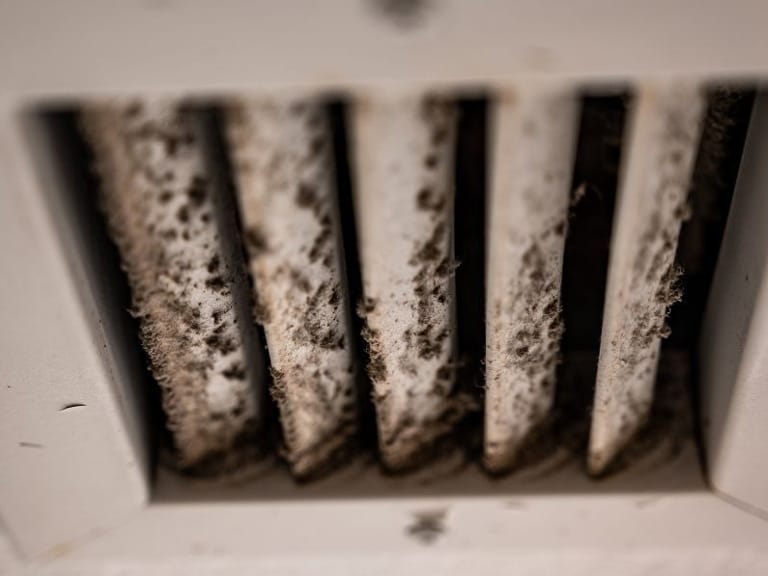Discovering mold in air ducts Raleigh homes is more common than most homeowners realize. With the Triangle area’s humid subtropical climate, your HVAC system can become a breeding ground for dangerous mold spores that circulate throughout your living space every time you turn on your heating or cooling system. This issue affects not only Raleigh, NC properties but also homes throughout surrounding communities including Wake Forest residents, Cary homeowners, and homeowners in Apex. Understanding how mold develops in ductwork, recognizing the warning signs, and knowing when to call professionals can protect your family’s health and your home’s air quality.
1. Why Mold Grows in Raleigh’s Air Ducts
Raleigh’s climate creates the perfect storm for mold in air ducts Raleigh homes and surrounding areas. The combination of warm temperatures, high humidity, and seasonal weather patterns provides ideal conditions for mold in HVAC system Raleigh properties, making professional remediation essential for maintaining healthy indoor air quality.
Raleigh’s Humid Climate Is a Major Factor
The Triangle area experiences over 119 humid days annually, with summer humidity levels often exceeding 70%. This moisture-rich environment affects Raleigh homeowners and surrounding communities equally, as the humid conditions extend throughout Wake County and beyond. When your air conditioning system cools warm, humid air, condensation forms on the cooler surfaces of your ductwork. Without proper ventilation and maintenance, this trapped moisture creates an ideal environment for mold spores to take hold and multiply.
During Raleigh’s hot summers, your HVAC system works overtime to cool your home. The temperature differential between the warm outdoor air and the cool air inside your ducts creates condensation that can accumulate in hard-to-reach areas of your ventilation system. This moisture, combined with dust and organic debris that naturally accumulates in ducts, provides everything mold in air ducts Raleigh systems needs to thrive and spread throughout your home.
Poor insulation around ductwork compounds the problem. When ducts aren’t properly insulated, the temperature difference between the duct surface and surrounding air increases condensation formation. Leaky ducts allow humid outdoor air to infiltrate the system, adding even more moisture to an already problematic environment.
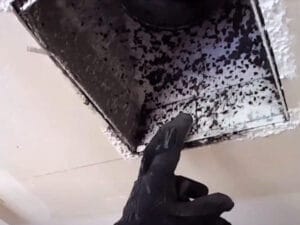
2. How to Tell If There’s Mold in Your Ducts
Identifying signs of mold in ductwork early can prevent serious health issues and extensive remediation costs. Mold growth in air ducts often goes unnoticed until it becomes a significant problem, making it crucial to recognize the warning signs.
The most obvious indicator is a persistent musty smell from HVAC system operation. This distinctive odor becomes stronger when your heating or cooling system runs and may be most noticeable near air return vents or supply registers. The smell often resembles wet cardboard, rotting wood, or a damp basement – clear warning signs that mold in air ducts Raleigh homeowners should never ignore.
Visual signs include black, green, or white patches around vent openings, on nearby walls, or visible inside accessible ductwork. You might notice dark dust particles blowing from vents or accumulating around air registers. This black dust often contains mold spores mixed with other contaminants.
Health symptoms in your household can also indicate mold contamination. Family members may experience increased allergy symptoms, respiratory irritation, chronic coughing, or headaches that seem to worsen when spending time indoors. These symptoms may be particularly noticeable when the HVAC system is running.
Professional inspection involves using specialized cameras to examine the interior of your ductwork. Trained technicians can identify mold in air ducts Raleigh properties in areas that aren’t visible to homeowners and document the extent of contamination with photographic evidence. This thorough assessment helps determine whether duct cleaning for mold Raleigh NC services are necessary and the scope of remediation required.
3. The Health Risks of Mold in Air Ducts
The health effects of mold in air ducts extend far beyond minor irritation. When mold grows in your HVAC system, it doesn’t remain contained—every time your system operates, mold spores circulate throughout your entire home, creating widespread exposure for all occupants.
Respiratory Symptoms Linked to HVAC Mold
Airborne mold spores can trigger immediate respiratory reactions in sensitive individuals. Common symptoms include persistent coughing, wheezing, shortness of breath, and chest tightness. These symptoms often worsen during peak HVAC usage periods when more contaminated air circulates through your home.
For individuals with asthma or other respiratory conditions, mold exposure can trigger severe attacks requiring medical intervention. The continuous circulation of mold spores through your HVAC system means exposure levels remain high, preventing symptoms from subsiding naturally.
Children and elderly family members face heightened risks due to developing or compromised immune systems. Long-term exposure to mold in air ducts Raleigh homes can lead to chronic respiratory issues, recurring sinus infections, and increased susceptibility to other respiratory illnesses that require ongoing medical treatment.
Understanding how mold in air ducts impacts allergies in Raleigh homes helps homeowners recognize when professional intervention becomes necessary to protect their family’s health.
4. Why Mold Contamination Is Hard to DIY
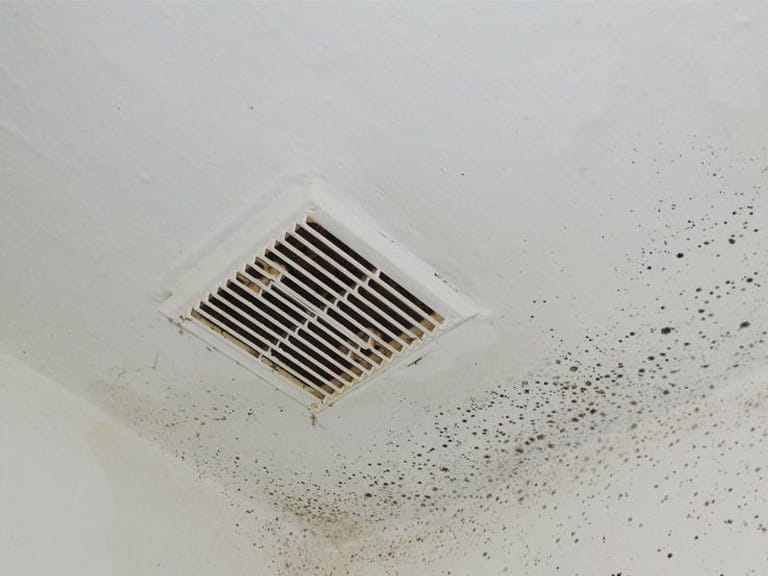
Many homeowners attempt to address mold contamination themselves, but mold remediation in air ducts requires specialized knowledge, equipment, and safety protocols that go beyond typical DIY capabilities. The complexity of modern HVAC systems makes thorough mold removal challenging for untrained individuals.
Ductwork extends throughout your home, often in crawl spaces, attics, and wall cavities that are difficult to access. Professional-grade equipment is needed to reach all areas where mold may be growing. Standard household cleaning products and equipment can’t effectively address contamination in these hidden spaces.
Simple solutions like bleach or fogging treatments may temporarily mask odors but fail to address the root cause of mold in air ducts Raleigh systems. Bleach doesn’t penetrate porous surfaces where mold roots can establish, allowing contamination to return quickly. Fog treatments may not reach all areas of the ductwork system, leaving untreated zones that can recontaminate cleaned areas.
Disturbing mold growth without proper containment and safety equipment can actually worsen the problem by releasing large quantities of spores into your living space. Professional remediation follows strict protocols to prevent cross-contamination and ensure complete removal.
5. How Professional Duct Cleaning Removes Mold Safely
Professional duct cleaning for mold Raleigh NC services follow National Air Duct Cleaners Association (NADCA) standards to ensure thorough, safe mold removal. This comprehensive process addresses not only visible mold growth but also the underlying conditions that allowed contamination to develop.
The process begins with a thorough inspection using specialized cameras to document the extent of mold in air ducts Raleigh contamination throughout your ductwork system. This assessment helps technicians develop a targeted remediation plan that addresses all affected areas and prevents future growth.
Professional-grade HEPA vacuum systems create negative pressure to contain mold spores during the cleaning process. These powerful systems prevent contaminated air from entering your living space while removing mold, dust, and debris from every accessible surface within your ductwork.
Specialized rotating brushes and compressed air tools agitate surfaces to dislodge embedded mold growth and debris. This mechanical action ensures thorough removal from all interior surfaces, including areas where mold may have established deep roots.
Following mechanical cleaning, EPA-approved antimicrobial treatments are applied to eliminate remaining mold spores and prevent future growth. These treatments are specifically designed for HVAC systems and won’t damage your equipment or pose health risks to occupants.
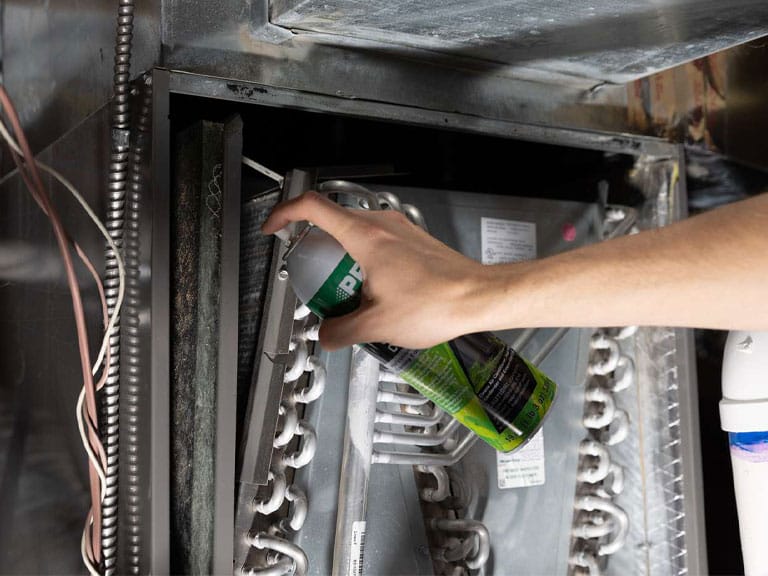
6. Should You Get a Mold Inspection First?
Deciding whether to schedule a separate mold inspection before duct cleaning depends on the severity of suspected contamination and your family’s health concerns. Professional mold inspectors can provide detailed testing and analysis, while experienced HVAC technicians can often identify mold issues during routine maintenance.
Independent mold inspections include air quality testing, surface sampling, and laboratory analysis to identify specific mold species and concentration levels. This information can be valuable for insurance claims, health assessments, or legal documentation, but may not be necessary for straightforward remediation decisions.
Many professional duct cleaning companies, including DuctNClean, offer comprehensive inspection services as part of their mold remediation process. These inspections use visual assessment, moisture measurement, and photographic documentation to evaluate contamination levels and develop appropriate treatment plans.
The inspection process helps determine whether mold growth is limited to your ductwork or if additional remediation may be needed in other areas of your home. This comprehensive approach ensures all mold issues are addressed simultaneously, preventing recontamination.
7. How Duct Cleaning Supports Mold Remediation
Professional duct cleaning plays a crucial role in comprehensive mold remediation by addressing contamination in your home’s air distribution system. This targeted approach complements other remediation efforts and helps prevent future mold growth throughout your property.
Removing mold from ductwork eliminates a major source of spore distribution that can recontaminate other areas of your home. Even if mold growth in living spaces is successfully treated, contaminated ductwork can quickly reintroduce spores and restart the contamination cycle.
The duct cleaning process also addresses moisture issues that contribute to mold growth. Sealing leaks, improving insulation, and optimizing system performance reduce the conditions that allow mold to establish and spread throughout your HVAC system.
For comprehensive mold issues beyond ductwork contamination, consult our complete guide to mold treatment and remediation in Raleigh to understand how professional services can address whole-home mold problems.
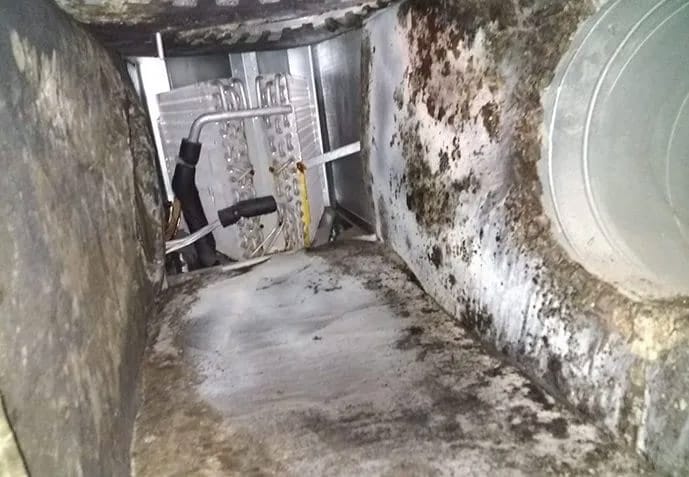
8. Recommended Duct Cleaning Schedule for Raleigh Homes
Raleigh’s humid climate and high HVAC usage create conditions that require more frequent duct maintenance than homes in drier climates. Understanding the optimal cleaning schedule can prevent mold in air ducts Raleigh properties and maintain healthy indoor air quality year-round.
General recommendations suggest Raleigh homes should schedule duct cleaning every 3–5 years, but several factors may require more frequent service. Homes with family members who suffer from allergies or respiratory conditions benefit from more frequent cleaning to minimize exposure to airborne contaminants.
Properties with pets, smokers, or recent renovations may need annual cleaning to address increased contaminant levels. The additional dust, dander, and construction debris in these environments provides more food sources for mold in air ducts Raleigh systems and can overwhelm standard filtration systems.
High-efficiency air filters should be changed monthly during peak usage seasons to prevent system strain and maintain optimal air quality. However, even the best filtration systems can’t completely prevent mold growth in humid climates without professional duct maintenance.
9. DuctNClean’s Mold Cleaning Process: What to Expect
Professional mold remediation through DuctNClean follows a systematic approach designed to eliminate existing contamination and prevent future growth. This comprehensive process ensures thorough treatment while minimizing disruption to your daily routine.
The initial consultation includes a detailed inspection of your HVAC system using specialized camera equipment to document mold growth and identify underlying moisture issues. This assessment helps develop a customized treatment plan that addresses your specific contamination concerns.
Before beginning work, technicians establish containment barriers to prevent mold spores from spreading to unaffected areas of your home. Negative air pressure systems ensure contaminated air is safely filtered and exhausted outside your living space.
The cleaning process uses powerful HEPA vacuum systems combined with specialized brushes and compressed air tools to remove mold growth from all accessible ductwork surfaces. This mechanical action followed by antimicrobial treatment ensures complete remediation.
Before and after photographs document the extent of contamination and the effectiveness of treatment. This visual evidence provides peace of mind and can be valuable for insurance documentation or health assessments.
Our residential duct cleaning services in Raleigh include comprehensive mold remediation as part of our commitment to improving your home’s air quality and protecting your family’s health.
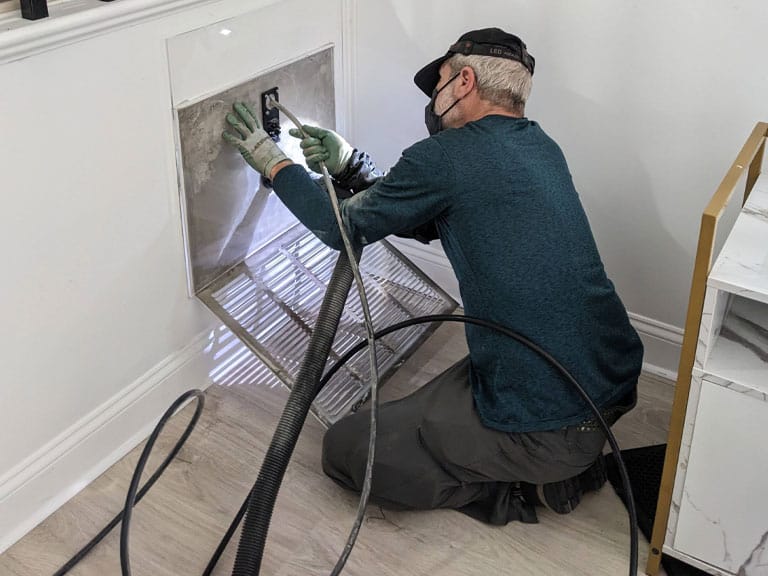
10. FAQs About Mold in Ductwork
1. How fast can mold grow inside air ducts in Raleigh?
In Raleigh’s humid climate, mold can begin growing inside your air ducts in as little as 24–48 hours if moisture and dust are present. Established colonies may form within a week if conditions remain favorable.
2. Can I use bleach to remove mold from my ducts?
No — bleach doesn’t penetrate porous duct materials where mold can root itself. Instead, professionals use EPA-approved antimicrobial treatments that are safe for HVAC systems and eliminate spores at the source.
3. Will duct cleaning eliminate all mold in my home?
Duct cleaning targets mold inside your HVAC system, but if mold is also present in walls, insulation, or crawlspaces, a full-home remediation may be required. A mold inspection can identify additional problem areas.
4. How do I prevent mold from returning after duct cleaning?
Keep humidity below 50%, replace filters monthly, seal duct leaks, and improve ventilation in moisture-prone areas. Routine HVAC maintenance is also key to long-term mold prevention.
5. Is hiring a pro for mold in air ducts really worth it?
Yes. Professionals use HEPA vacuums, containment barriers, and HVAC-safe biocides to remove mold safely and thoroughly — something DIY solutions simply can’t match. It’s safer, more effective, and saves money long term.
6. What does mold in air ducts smell like?
Mold in your ductwork often produces a musty, earthy odor — similar to wet cardboard or a damp basement. If you smell this when your HVAC turns on, it may signal hidden mold inside your vents.
7. Can mold in ducts cause long-term health problems?
Yes. Prolonged exposure to airborne mold can lead to chronic respiratory issues, fatigue, sinus infections, and even neurological symptoms in severe cases. Children, seniors, and allergy sufferers are especially vulnerable.
8. How much does it cost to remove mold from air ducts in Raleigh?
Mold remediation for air ducts in Raleigh typically ranges from $300 to $800, depending on contamination severity and HVAC system size. Full-home mold remediation may cost more if other areas are affected.
11. Local Areas Most Affected by Mold in HVAC Systems
Certain areas throughout the Triangle region experience higher rates of mold in air ducts Raleigh contamination due to specific environmental conditions and housing characteristics. Understanding these patterns can help homeowners assess their risk levels and take appropriate preventive measures.
Brier Creek area homes, particularly those built in the 1990s and 2000s, often experience duct mold issues due to the area’s proximity to water features and lower elevation. The combination of older ductwork and high humidity creates ideal conditions for mold growth.
North Hills properties, especially high-rise condominiums and townhomes, face unique challenges with shared HVAC systems and limited ventilation. The dense construction and shared air handling systems can allow mold contamination to spread between units.
Downtown Raleigh historic homes often struggle with outdated ductwork that lacks proper insulation and sealing. These older systems, combined with the urban heat island effect, create temperature differentials that promote condensation and mold growth.
Five Points area homes, particularly those in lower-lying areas, experience higher groundwater levels and basement moisture issues that can contribute to HVAC system contamination. The combination of older infrastructure and environmental factors requires more frequent maintenance.
Wake Forest residents often deal with mold issues in newer subdivisions where rapid construction sometimes compromises proper duct sealing and insulation. The area’s rolling terrain and proximity to Falls Lake create microclimates with varying humidity levels.
Cary homeowners in established neighborhoods may encounter mold problems in homes built during the 1980s building boom, when duct sealing standards were less stringent. The town’s numerous retention ponds and green spaces contribute to elevated local humidity levels.
Homeowners in Apex frequently experience duct mold issues in properties located in lower-lying areas near Jordan Lake and the Haw River watershed. The combination of natural moisture sources and rapid residential development creates conditions conducive to mold growth.
Other affected areas throughout the Triangle include Morrisville, Garner, Knightdale, and Fuquay-Varina, where similar climate conditions and housing characteristics create comparable mold risks for HVAC systems.
12. Call DuctNClean today!
Don’t let mold in air ducts Raleigh compromise your family’s health and comfort. Professional duct cleaning and mold remediation can eliminate contamination, improve air quality, and prevent future growth. Our experienced technicians serve Raleigh, NC and surrounding communities throughout the Triangle area, using industry-leading equipment and techniques to ensure thorough, safe mold removal from your HVAC system.
Whether you’re dealing with mold issues in Wake Forest, Cary, Apex, or anywhere else in the Triangle region, our team is ready to help restore your home’s air quality.
Schedule your free inspection today and breathe easier tomorrow.
📞 Call Us: 984-301-8445
Take the first step toward cleaner, healthier indoor air. Our team is ready to assess your ductwork, document any mold contamination, and provide a comprehensive treatment plan tailored to your home’s specific needs. Contact us today to protect your family’s health and your home’s air quality.



